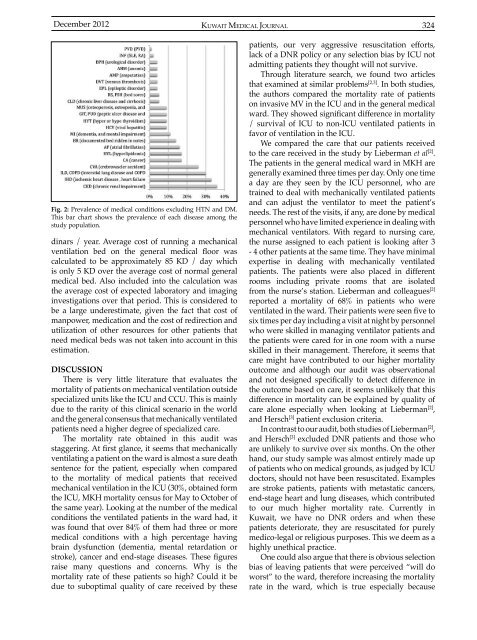Vol 44 # 4 December 2012 - Kma.org.kw
Vol 44 # 4 December 2012 - Kma.org.kw
Vol 44 # 4 December 2012 - Kma.org.kw
Create successful ePaper yourself
Turn your PDF publications into a flip-book with our unique Google optimized e-Paper software.
<strong>December</strong> <strong>2012</strong><br />
KUWAIT MEDICAL JOURNAL 324<br />
Fig. 2: Prevalence of medical conditions excluding HTN and DM.<br />
This bar chart shows the prevalence of each disease among the<br />
study population.<br />
dinars / year. Average cost of running a mechanical<br />
ventilation bed on the general medical floor was<br />
calculated to be approximately 85 KD / day which<br />
is only 5 KD over the average cost of normal general<br />
medical bed. Also included into the calculation was<br />
the average cost of expected laboratory and imaging<br />
investigations over that period. This is considered to<br />
be a large underestimate, given the fact that cost of<br />
manpower, medication and the cost of redirection and<br />
utilization of other resources for other patients that<br />
need medical beds was not taken into account in this<br />
estimation.<br />
DISCUSSION<br />
There is very little literature that evaluates the<br />
mortality of patients on mechanical ventilation outside<br />
specialized units like the ICU and CCU. This is mainly<br />
due to the rarity of this clinical scenario in the world<br />
and the general consensus that mechanically ventilated<br />
patients need a higher degree of specialized care.<br />
The mortality rate obtained in this audit was<br />
staggering. At first glance, it seems that mechanically<br />
ventilating a patient on the ward is almost a sure death<br />
sentence for the patient, especially when compared<br />
to the mortality of medical patients that received<br />
mechanical ventilation in the ICU (30%, obtained form<br />
the ICU, MKH mortality census for May to October of<br />
the same year). Looking at the number of the medical<br />
conditions the ventilated patients in the ward had, it<br />
was found that over 84% of them had three or more<br />
medical conditions with a high percentage having<br />
brain dysfunction (dementia, mental retardation or<br />
stroke), cancer and end-stage diseases. These figures<br />
raise many questions and concerns. Why is the<br />
mortality rate of these patients so high? Could it be<br />
due to suboptimal quality of care received by these<br />
patients, our very aggressive resuscitation efforts,<br />
lack of a DNR policy or any selection bias by ICU not<br />
admitting patients they thought will not survive.<br />
Through literature search, we found two articles<br />
that examined at similar problems [2,3] . In both studies,<br />
the authors compared the mortality rate of patients<br />
on invasive MV in the ICU and in the general medical<br />
ward. They showed significant difference in mortality<br />
/ survival of ICU to non-ICU ventilated patients in<br />
favor of ventilation in the ICU.<br />
We compared the care that our patients received<br />
to the care received in the study by Lieberman et al [2] .<br />
The patients in the general medical ward in MKH are<br />
generally examined three times per day. Only one time<br />
a day are they seen by the ICU personnel, who are<br />
trained to deal with mechanically ventilated patients<br />
and can adjust the ventilator to meet the patient’s<br />
needs. The rest of the visits, if any, are done by medical<br />
personnel who have limited experience in dealing with<br />
mechanical ventilators. With regard to nursing care,<br />
the nurse assigned to each patient is looking after 3<br />
- 4 other patients at the same time. They have minimal<br />
expertise in dealing with mechanically ventilated<br />
patients. The patients were also placed in different<br />
rooms including private rooms that are isolated<br />
from the nurse’s station. Lieberman and colleagues [2]<br />
reported a mortality of 68% in patients who were<br />
ventilated in the ward. Their patients were seen five to<br />
six times per day including a visit at night by personnel<br />
who were skilled in managing ventilator patients and<br />
the patients were cared for in one room with a nurse<br />
skilled in their management. Therefore, it seems that<br />
care might have contributed to our higher mortality<br />
outcome and although our audit was observational<br />
and not designed specifically to detect difference in<br />
the outcome based on care, it seems unlikely that this<br />
difference in mortality can be explained by quality of<br />
care alone especially when looking at Lieberman [2] ,<br />
and Hersch [3] patient exclusion criteria.<br />
In contrast to our audit, both studies of Lieberman [2] ,<br />
and Hersch [3] excluded DNR patients and those who<br />
are unlikely to survive over six months. On the other<br />
hand, our study sample was almost entirely made up<br />
of patients who on medical grounds, as judged by ICU<br />
doctors, should not have been resuscitated. Examples<br />
are stroke patients, patients with metastatic cancers,<br />
end-stage heart and lung diseases, which contributed<br />
to our much higher mortality rate. Currently in<br />
Kuwait, we have no DNR orders and when these<br />
patients deteriorate, they are resuscitated for purely<br />
medico-legal or religious purposes. This we deem as a<br />
highly unethical practice.<br />
One could also argue that there is obvious selection<br />
bias of leaving patients that were perceived “will do<br />
worst” to the ward, therefore increasing the mortality<br />
rate in the ward, which is true especially because
















